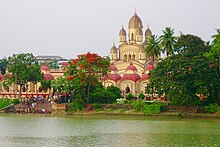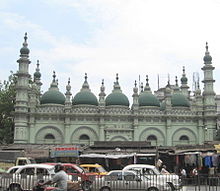Tourism in West Bengal: Difference between revisions
Tamravidhir (talk | contribs) →Costumes: adding pic |
Tamravidhir (talk | contribs) →Religion: adding info |
||
| Line 25: | Line 25: | ||
| title= The chattering masses |work= The New York Times |date= 15 May 2005 |accessdate= 26 April 2006}}</ref><ref>{{cite news |author= Mukherjee Pandey, Jhimli |title= Presidency old-timers to relive days of canteen adda |url= http://articles.timesofindia.indiatimes.com/2008-11-01/kolkata/27941063_1_canteen-girl-students-presidency-college |accessdate= 23 January 2012 |newspaper= Times of India |date= 1 November 2008}}</ref> Typically, every para has its own community club, with a club room ("club ghar"), and often a playing field. People of a para habitually indulge in [[Adda (South Asian)|adda]] or leisurely chat in "rock"s or "rowacks" (porches) and teashops in the evenings after work. Sports ([[cricket]], [[football (soccer)|football]], [[badminton]]) and indoor games ([[carrom]]) tournaments are regularly organized on an inter-para basis. |
| title= The chattering masses |work= The New York Times |date= 15 May 2005 |accessdate= 26 April 2006}}</ref><ref>{{cite news |author= Mukherjee Pandey, Jhimli |title= Presidency old-timers to relive days of canteen adda |url= http://articles.timesofindia.indiatimes.com/2008-11-01/kolkata/27941063_1_canteen-girl-students-presidency-college |accessdate= 23 January 2012 |newspaper= Times of India |date= 1 November 2008}}</ref> Typically, every para has its own community club, with a club room ("club ghar"), and often a playing field. People of a para habitually indulge in [[Adda (South Asian)|adda]] or leisurely chat in "rock"s or "rowacks" (porches) and teashops in the evenings after work. Sports ([[cricket]], [[football (soccer)|football]], [[badminton]]) and indoor games ([[carrom]]) tournaments are regularly organized on an inter-para basis. |
||
====Religion==== |
====Religion and Language==== |
||
{{Main|Bengali people}} |
|||
Religion, specially [[Hinduism]], the principal religion at 72.5% of the total population, plays a vital role in the culture of West Bengal. [[Durga Puja]], a five-day annual autumnal celebration of [[Hindu]] [[goddess]] [[Durga]]’s victory over [[Mahishasura]], a [[Minotaur]]-like demon, is the biggest festival of the state. The [[Kali Puja|Festival of Kali]], the guardian deity of Bengal, is also celebrated with great enthusiasm. Other important festivals include the seasonal festivals introduced by Rabindranath Tagore, book fairs, film and drama festivals and traditional village fairs etc. |
|||
{{Multiple image |
|||
| align = right |
|||
| direction = vertical |
|||
| header = |
|||
| header_align = left/right/center |
|||
| header_background = |
|||
| footer = |
|||
| footer_align = left/right/center |
|||
| footer_background = |
|||
| width = 220 |
|||
| image1 = Kolkatatemple.jpg|thumb |
|||
| width1 = |
|||
| alt1 = |
|||
| caption1 =[[Dakshineswar Kali Temple]] |
|||
| image2 = Kolkata Tipu Sultan's Mosque3.jpg|thumb |
|||
| width2 = |
|||
| alt2 = |
|||
| caption2 =[[Tipu Sultan Mosque]] |
|||
}} |
|||
Majority of the population comprises [[Bengali people|Bengalis]].<ref name=ethnic1>{{cite book |title= Ethnic realignments: a comparative study of government influences on identity|last= Hoddie|first=Matthew |year= 2006|publisher= Lexington Books |isbn= 978-0-7391-1325-7|pages= 114–115|url= http://books.google.com/books?id=6ka0nMJgKbYC|accessdate=16 February 2012}}</ref> The [[Marwaris]], [[Bihari people|Bihari]] and [[Oriya people|Oriya]] minority are scattered throughout the state; communities of [[Sherpa (people)|Sherpas]] and ethnic [[Tibetan people|Tibetans]] can be found in [[Darjeeling Himalayan hill region]]. Darjeeling district has a large number of [[Gurkha]] people of [[Nepal]]ese origin. West Bengal is home to indigenous tribal ''[[Adivasi]]s'' such as [[Santals]], [[Kol (people)|Kol]], [[Rajbongshi|Koch-Rajbongshi]] and [[Toto tribe]]. There are a small number of [[Ethnic communities in Kolkata|ethnic minorities]] primarily in the state capital, including [[Overseas Chinese|Chinese]], [[Tamil people|Tamils]], [[Gujarati people|Gujaratis]], [[Anglo-Indian]]s, [[Armenians in India|Armenians]], [[Punjabis]], and [[Parsi people|Parsis]].<ref name="BanerjeePage3"> {{cite book|editor1-last =Banerjee|editor1-first=Himadri|editor2-last=Gupta|editor2-first=Nilanjana |editor3-last=Mukherjee |editor3-first= Sipra|title=Calcutta mosaic: essays and interviews on the minority communities of Calcutta|url=http://books.google.com/books?id=cSTEOx_Lw9MC&dq|accessdate=29 January 2012|year=2009|publisher=Anthem Press|isbn=978-81-905835-5-8|page=3}}</ref> India's sole [[Chinatown]] is in eastern Kolkata.<ref name="BanerjeePage10"> {{cite book|editor1-last =Banerjee|editor1-first=Himadri|editor2-last=Gupta|editor2-first=Nilanjana |editor3-last=Mukherjee |editor3-first= Sipra|title=Calcutta mosaic: essays and interviews on the minority communities of Calcutta|url=http://books.google.com/books?id=cSTEOx_Lw9MC&dq|accessdate=29 January 2012|year=2009|publisher=Anthem Press|isbn=978-81-905835-5-8|pages=9–10}}</ref> |
|||
The official language is [[Bengali language|Bengali]] and English.<ref name=nclmanurep2010>{{cite web |url=http://nclm.nic.in/shared/linkimages/NCLM47thReport.pdf |title= Report of the Commissioner for linguistic minorities: 47th report (July 2008 to June 2010)|pages=122–126 |publisher=Commissioner for Linguistic Minorities, Ministry of Minority Affairs, |
|||
Government of India |accessdate=16 February 2012}}</ref> [[Nepali language|Nepali]] is the official language in three subdivisions of [[Darjeeling district]].<ref name=nclmanurep2010/> As of 2001, in descending order of number of speakers, the languages of the state are: Bengali, [[Hindi]], [[Santali language|Santali]], [[Urdu]], Nepali, and [[Oriya language|Oriya]].<ref name=nclmanurep2010/> Languages such as [[Rajbanshi language|Rajbongshi]] and [[Ho language|Ho]] are used in some parts of the state. |
|||
As of 2001, [[Hinduism]] is the principal religion at 72.5% of the total population, while [[Muslim]]s comprise 25.2% of the total population , being the second-largest community as also the largest minority group; [[Sikhism]], Christianity and other religions make up the remainder.<ref name=relegionindia>{{cite web |
|||
| url = http://www.censusindia.gov.in/|title=Data on Religion|accessdate=August 26, 2006 |
|||
|work=Census of India (2001)|publisher=Office of the Registrar General & Census Commissioner, India|archiveurl=http://web.archive.org/web/20070812142520/http://www.censusindia.net/religiondata/ |
|||
|archivedate= August 12, 2007}}</ref> |
|||
====Literature==== |
====Literature==== |
||
Revision as of 15:19, 27 May 2012
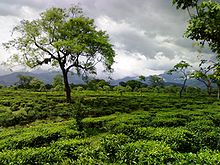
West Bengal Tourism refers to the Tourism in West Bengal, a state in the eastern region of India and is the nation's fourth-most populous.[1] It is also the seventh-most populous sub-national entity in the world, with over 91 million inhabitants.[1] Covering a total area of 34,267 sq mi (88,750 km2), it is bordered by the countries of Nepal, Bhutan, and Bangladesh, and the Indian states of Orissa, Jharkhand, Bihar, Sikkim, and Assam. The state capital is Kolkata (formerly Calcutta). West Bengal encompasses two broad natural regions: the Gangetic Plain in the south and the sub-Himalayan and Himalayan area in the north.
West Bengal is on the eastern bottleneck of India, stretching from the Himalayas in the north to the Bay of Bengal in the south. The state has a total area of 88,752 square kilometres (34,267 sq mi).[2] The Darjeeling Himalayan hill region in the northern extreme of the state belongs to the eastern Himalaya. This region contains Sandakfu (3,636 m or 11,929 ft)—the highest peak of the state.[3] The narrow Terai region separates this region from the plains, which in turn transitions into the Ganges delta towards the south. The Rarh region intervenes between the Ganges delta in the east and the western plateau and high lands. A small coastal region is on the extreme south, while the Sundarbans mangrove forests form a remarkable geographical landmark at the Ganges delta.
During the British colonial era from 1700–1912, when Kolkata (then known as Calcutta) was the capital of British India and , Kolkata witnessed a spate of frenzied construction activity of buildings largely influenced by the conscious intermingling of Neo-Gothic, Baroque, Neo-Classical, Oriental and Islamic schools of design. Unlike many north Indian cities, whose construction stresses minimalism, the layout of much of the architectural variety in Kolkata owes its origins to European styles and tastes imported by the British and, to a much lesser extent, the Portuguese and French.
Kolkata the state capital is considered to be an ideal hub to cover all the destinations in West Bengal.
Heritage
Architectural and Natural

The state of West Bengal is rich in both architectural and cultural heritage. The capital of the state, Kolkata is also known as the "City of Palaces". The River Ganga, which is sacred flows through Kolkata. Except the heritage buildings there are also high rising monuments and skyscrapers. There are also some World heritage sites like Darjeeling Himalayan Railway and Sundarbans National Park. West Bengal is also famous for its terracotta temples, especially the temples at Bishnupur and Neora Valley National Park, which is one of the richest biological zones in the entire Northeast situated in the Kalimpong subdivision under Darjeeling District in West Bengal.
Cultural
The culture of West Bengal has its roots in literature, music, fine arts, drama and cinema. But, the Darjeeling Himalayan hill region shows particularly different cultural aspect.
West Bengal's capital Kolkata—as the former capital of India—was the birthplace of modern Indian literary and artistic thought,[4] and is referred to as the "cultural capital of India".[5][6]
Para, Adda, and club culture
The presence of paras, which are neighbourhoods that possess a strong sense of community, is characteristic of West Bengal.[7] Typically, each para has its own community club and, on occasion, a playing field.[7] Residents engage in addas, or leisurely chats, that often take the form of freestyle intellectual conversation.[8][9] Typically, every para has its own community club, with a club room ("club ghar"), and often a playing field. People of a para habitually indulge in adda or leisurely chat in "rock"s or "rowacks" (porches) and teashops in the evenings after work. Sports (cricket, football, badminton) and indoor games (carrom) tournaments are regularly organized on an inter-para basis.
Religion and Language
Majority of the population comprises Bengalis.[10] The Marwaris, Bihari and Oriya minority are scattered throughout the state; communities of Sherpas and ethnic Tibetans can be found in Darjeeling Himalayan hill region. Darjeeling district has a large number of Gurkha people of Nepalese origin. West Bengal is home to indigenous tribal Adivasis such as Santals, Kol, Koch-Rajbongshi and Toto tribe. There are a small number of ethnic minorities primarily in the state capital, including Chinese, Tamils, Gujaratis, Anglo-Indians, Armenians, Punjabis, and Parsis.[11] India's sole Chinatown is in eastern Kolkata.[12]
The official language is Bengali and English.[13] Nepali is the official language in three subdivisions of Darjeeling district.[13] As of 2001, in descending order of number of speakers, the languages of the state are: Bengali, Hindi, Santali, Urdu, Nepali, and Oriya.[13] Languages such as Rajbongshi and Ho are used in some parts of the state.
As of 2001, Hinduism is the principal religion at 72.5% of the total population, while Muslims comprise 25.2% of the total population , being the second-largest community as also the largest minority group; Sikhism, Christianity and other religions make up the remainder.[14]
Literature
The Bengali language boasts a rich literary heritage, shared with neighbouring Bangladesh. West Bengal has a long tradition in folk literature, evidenced by the Charyapada, Mangalkavya, Shreekrishna Kirtana, Thakurmar Jhuli, and stories related to Gopal Bhar. In the nineteenth and twentieth century, Bengali literature was modernized in the works of authors such as Bankim Chandra Chattopadhyay, Michael Madhusudan Dutt, Rabindranath Tagore, Kazi Nazrul Islam, Sharat Chandra Chattopadhyay, Jibananda Das and Manik Bandyopadhyay. In modern times Jibanananda Das, Bibhutibhushan Bandopadhyay, Tarashankar Bandopadhyay, Manik Bandopadhyay, Ashapurna Devi, Shirshendu Mukhopadhyay, Buddhadeb Guha, Mahashweta Devi, Samaresh Majumdar, Sanjeev Chattopadhyay and Sunil Gangopadhyay among others are well known.
West Bengal has a long tradition of popular literature, music and drama largely based on Bengali folklore and Hindu epics and Puranas.

Music and Dance
The Baul tradition is a unique heritage of Bengali folk music, which has also been influenced by regional music traditions.[17] Other folk music forms include Gombhira and Bhawaiya. Folk music in West Bengal is often accompanied by the ektara, a one-stringed instrument. West Bengal also has an heritage in North Indian classical music. "Rabindrasangeet", songs composed and set into tune by Rabindranath Tagore and "Nazrul geeti" (by Kazi Nazrul Islam) are popular. Also prominent are other musical forms like Dwijendralal, Atulprasad and Rajanikanta's songs, and "adhunik" or modern music from films and other composers.
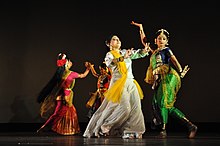
From the early 1990s, there has been an emergence and popularisation of new genres of music, including fusions of Baul and Jazz by several Bangla bands, as well as the emergence of what has been called Jeebonmukhi Gaan (a modern genre based on realism). Bengali dance forms draw from folk traditions, especially those of the tribal groups, as well as the broader Indian dance traditions. Chau dance of Purulia is a rare form of mask dance. State is known for Bengali folk music such as baul and kirtans and gajan, and modern songs including Bengali adhunik songs. From the early 1990s, there has been an emergence of new genres of music, including the emergence of what has been called Bengali Jeebonmukhi Gaan (a modern genre based on realism) by artists like Anjan Dutta, Kabir Suman, Nachiketa and folk/alternative/rock bands like Moheener Ghoraguli, Chandrabindoo, Bhoomi, Cactus and Fossils. Dutta's songs are influenced by classical music, and especially country music and blues and Bob Dylan and Leonard Cohen which he fused with Bengali tradition of east west, as did Suman. American urban folk and grunge are also an inspiration for this generation.[18]
Films
Mainstream Hindi films are popular in Bengal, and the state is home to a thriving cinema industry, dubbed "Tollywood". Tollygunj in Kolkata is the location of numerous Bengali movie studios, and the name "Tollywood" (similar to Hollywood and Bollywood) is derived from that name. The Bengali film industry is well known for its art films, and has produced acclaimed directors like Satyajit Ray, Mrinal Sen, Tapan Sinha and Ritwik Ghatak. Prominent contemporary directors include Buddhadev Dasgupta, Goutam Ghose, Aparna Sen and Rituparno Ghosh.
Among other types of theater, West Bengal has a tradition of folk drama known as jatra.[19][20] Kolkata is the home of the Bengali cinema industry, dubbed "Tollywood" for Tollygunj, where most of the state's film studios are located.[21] Its long tradition of art films includes globally acclaimed film directors such as Academy Award-winning director Satyajit Ray, Ritwik Ghatak, Mrinal Sen, Tapan Sinha, and contemporary directors such as Aparna Sen, Buddhadeb Dasgupta, and Rituparno Ghosh.[22]
Fine arts
Bengal had been the harbinger of modernism in fine arts. Abanindranath Tagore, called the father of Modern Indian Art had started the Bengal School of Art which was to create styles of art outside the European realist tradition which was taught in art colleges under the colonial administration of the British Government. The movement had many adherents like Gaganendranath Tagore, Ramkinkar Baij, Jamini Roy and Rabindranath Tagore. After Indian Independence, important groups like the Calcutta Group and the Society of Contemporary Artists were formed in Bengal which dominated the art scene in India.
Reformist heritage
The capital, Kolkata, was the workplace of several social reformers, like Raja Ram Mohan Ray, Iswar Chandra Vidyasagar, and Swami Vivekananda. These social reforms have eventually led to a cultural atmosphere where practices like sati, dowry, and caste-based discrimination or untouchability, the evils that crept into the Hindu society, were abolished.
Cuisine
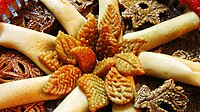
Rice and fish are traditional favourite foods, leading to a saying in Bengali, machhe bhate bangali, that translates as "fish and rice make a Bengali".[23] Bengal's vast repertoire of fish-based dishes includes hilsa preparations, a favorite among Bengalis. There are numerous ways of cooking fish depending on the texture, size, fat content and the bones. Sweets occupy an important place in the diet of Bengalis and at their social ceremonies. It is an ancient custom among both Hindu and Muslim Bengalis to distribute sweets during festivities. The confectionery industry has flourished because of its close association with social and religious ceremonies. Competition and changing tastes have helped to create many new sweets. Bengalis make distinctive sweetmeats from milk products, including Rôshogolla, Chômchôm, Kalojam and several kinds of sondesh. Pitha, a kind of sweet cake, bread or dimsum are specialties of winter season. Sweets like coconut-naru, til-naru, moa, payesh, etc. are prepared during the festival of Lakshmi puja. Popular street food includes Aloor Chop, Beguni, Kati roll, and phuchka.[24][25]
The variety of fruits and vegetables that Bengal has to offer is incredible. A host of gourds, roots and tubers, leafy greens, succulent stalks, lemons and limes, green and purple eggplants, red onions, plantain, broad beans, okra, banana tree stems and flowers, green jackfruit and red pumpkins are to be found in the markets or anaj bazaar as popularly called. Panta bhat (rice soaked overnight in water)with onion & green chili is a traditional dish consumed in rural areas. Common spices found in a Bengali kitchen are cumin, ajmoda (radhuni), bay leaf, mustard, ginger, green chillies, turmeric, etc. People of erstwhile East Bengal use a lot of ajmoda, coriander leaves, tamarind, coconut and mustard in their cooking; while those aboriginally from West Bengal use a lot of sugar, garam masala and red chilli powder. Vegetarian dishes are mostly without onion and garlic.
Costumes

Bengali women commonly wear the shaŗi , often distinctly designed according to local cultural customs. In urban areas, many women and men wear Western attire. Among men, western dressing has greater acceptance. Men also wear traditional costumes such as the panjabi with dhuti, often on cultural occasions.
Festivals


Durga Puja in October is the most popular festival in the West Bengal.[26] Poila Baishakh (the Bengali New Year), Rathayatra, Dolyatra or Basanta-Utsab, Nobanno, Poush Parbon (festival of Poush), Kali Puja, SaraswatiPuja, LaxmiPuja, Christmas, Eid ul-Fitr, Eid ul-Adha and Muharram are other major festivals. Buddha Purnima, which marks the birth of Gautama Buddha, is one of the most important Hindu/Buddhist festivals while Christmas, called Bôŗodin (Great day) in Bengali is celebrated by the minority Christian population. Poush Mela is a popular festival of Shantiniketan, taking place in winter. West Bengal has been home to several famous religious teachers, including Sri Chaitanya, Sri Ramakrishna, Swami Vivekananda, A. C. Bhaktivedanta Swami Prabhupada and Paramahansa Yogananda. The swami is credited with introducing Hinduism to western society and became a religious symbol of the nation in the eyes of the intellectuals of the west.
Culture of Darjeeling Himalayan Hill Region
Apart from the major Hindu religious festivals like Diwali, Christmas, Dussera, Holi, Ram Navami, the diverse ethnic populace of Darjeeling Himalayan hill region celebrates several local festivals. The Tibetan ethnic groups like the Lepchas, Bhutias, Gurungs, and Tamangs celebrate new year called Losar in January/February, Maghe Sankranti, Chotrul Duchen, Buddha Jayanti, and Tendong Lho Rumfaat, to name a few, which provide the "regional distinctness" of Darjeeling's local culture from the rest of West Bengal.
A popular food in Darjeeling is the momo, a steamed dumpling containing either mutton, pork, beef or vegetables cooked in a doughy wrapping served with a watery vegetable soup and spicy tomato sauce/chutney. Wai-Wai is a favorite packaged snack of Darjeeling hills comprising noodles which are eaten either dry or with soup. Churpee, a kind of hard cheese made from cow or yak's milk is another popular mini-snack that is both nutritious and a pastime. A form of noodle called thukpa, served with soup and vegetables, is extremely popular in and around the hills of Darjeeling. Chhang and tongba are local alcoholic beverage made from millet.
References
- ^ a b "India: Administrative Divisions (population and area)". Census of India. Retrieved April 17, 2009.
- ^ "Area, population, decennial growth rate and density for 2001 and 2011 at a glance for West Bengal and the districts: provisional population totals paper 1 of 2011: West Bengal". Registrar General & Census Commissioner, India. Retrieved 26 January 2012.
- ^ Pal, Supratim (14 May 2007). "Top of world in kingdom of cloud". The Telegraph. Kolkata. Retrieved 16 February 2012.
- ^ Chaudhuri, Nirad C. (2001). The autobiography of an unknown Indian. New York Review of Books. p. 269. ISBN 978-0-940322-82-0.
- ^ Reeves, Philip (5 April 2007). "Calcutta: habitat of the Indian intellectual". National Public Radio. Retrieved 29 January 2012.
- ^ Noble, Allen and Frank Costa (1990). Regional development and planning for the 21st century : new priorities, new philosophies. Ashgate Pub Ltd. pp. 282, 396. ISBN 978-1-84014-800-8.
{{cite book}}: Unknown parameter|coauthors=ignored (|author=suggested) (help) - ^ a b "Kolkata culture: Para". Department of Tourism, Government of West Bengal. Retrieved 9 December 2011.
- ^ Trachtenberg, P. (15 May 2005). "The chattering masses". The New York Times. Retrieved 26 April 2006.
- ^ Mukherjee Pandey, Jhimli (1 November 2008). "Presidency old-timers to relive days of canteen adda". Times of India. Retrieved 23 January 2012.
- ^ Hoddie, Matthew (2006). Ethnic realignments: a comparative study of government influences on identity. Lexington Books. pp. 114–115. ISBN 978-0-7391-1325-7. Retrieved 16 February 2012.
- ^ Banerjee, Himadri; Gupta, Nilanjana; Mukherjee, Sipra, eds. (2009). Calcutta mosaic: essays and interviews on the minority communities of Calcutta. Anthem Press. p. 3. ISBN 978-81-905835-5-8. Retrieved 29 January 2012.
- ^ Banerjee, Himadri; Gupta, Nilanjana; Mukherjee, Sipra, eds. (2009). Calcutta mosaic: essays and interviews on the minority communities of Calcutta. Anthem Press. pp. 9–10. ISBN 978-81-905835-5-8. Retrieved 29 January 2012.
- ^ a b c "Report of the Commissioner for linguistic minorities: 47th report (July 2008 to June 2010)" (PDF). Commissioner for Linguistic Minorities, Ministry of Minority Affairs,
Government of India. pp. 122–126. Retrieved 16 February 2012.
{{cite web}}: line feed character in|publisher=at position 70 (help) - ^ "Data on Religion". Census of India (2001). Office of the Registrar General & Census Commissioner, India. Archived from the original on August 12, 2007. Retrieved August 26, 2006.
- ^
Georg, Feuerstein (2002). The Yoga Tradition. Motilal Banarsidass. p. 600. ISBN 3-935001-06-1.
{{cite book}}: Cite has empty unknown parameter:|coauthors=(help) - ^ Clarke, Peter Bernard (2006). New Religions in Global Perspective. Routledge. p. 209. ISBN 0-7007-1185-6.
- ^ "The Bauls of Bengal". Folk Music. BengalOnline. Retrieved October 26, 2006.
- ^ "Chau: The Rare Mask Dances". Dances of India. Boloji.com. Retrieved October 22, 2006.
- ^ Chakraborty, Ajanta (5 July 2011). "Meet the new Mamata Banerjee". Times of India. Retrieved 23 January 2012.
The jatra industry based out of Kolkata's Chitpur Road has gone through a severe blow with the growth of video parlours.
- ^ Niyogi, Subhro (26 October 2010). "Red alert For Jatra". Times of India. Retrieved 23 January 2012.
- ^ Sarkar, Bhaskar (March 2008). "The melodramas of globalization". Cultural Dynamics. 20 (1): pp. 31–51 [34]. doi:10.1177/0921374007088054.
{{cite journal}}:|pages=has extra text (help)CS1 maint: date and year (link). - ^ Gooptu, Sharmistha (2010). Bengali cinema: 'an other nation'. Taylor & Francis. pp. 2, 172, 181, 187. ISBN 978-0-415-57006-0. Retrieved 24 January 2012.
- ^ Gertjan de Graaf, Abdul Latif. "Development of freshwater fish farming and poverty alleviation: A case study from Bangladesh" (PDF). Aqua KE Government. Retrieved October 22, 2006.
- ^ Saha, S (January 18, 2006). "Resurrected, the kathi roll – Face-off resolved, Nizam's set to open with food court". Calcutta, India: The Telegraph (Kolkata). Retrieved October 26, 2006.
- ^ "Mobile food stalls". Bangalinet.com. Retrieved October 26, 2006.
- ^ "Durga Puja". Festivals celebrated throughout West Bengal. Department of Tourism, Government of West Bengal. Retrieved 5 March 2012.

